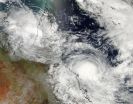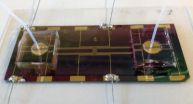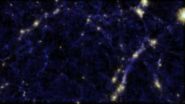(Press-News.org) On Friday, March 7 there were two tropical lows located east and west of Queensland, Australia. Those lows organized and intensified into Tropical Cyclone Gillian and Hadi and were caught together in one amazing image from NASA's Aqua satellite. While Gillian has already made one landfall and is expected to make another, Hadi is turning tail and running from the mainland.
NASA's Aqua satellite passed over Queensland on March 10 at 04:00 UTC and the Moderate Resolution Imaging Spectroradiometer instrument known as MODIS captured Tropical Cyclones Gillian in the Gulf of Carpentaria, just west of Queensland's York Peninsula, and Hadi in the Coral Sea, east of Queensland.
On March 10 at 0300 UTC, Tropical Cyclone Gillian, formerly known as the low pressure area "System 98P" had maximum sustained winds near 35 knots/40 mph/62 kph. It was located about 230 nautical miles northeast of Mornington Island. Gillian is moving to the southeast at 5 knots/5.7 mph/9.2 kph, but is expected to re-curve to the southwest.
The Joint Typhoon Warning Center or JTWC noted that animated multi-spectral satellite imagery and radar from Weipa showed that the center made landfall in the northwestern coast of the York Peninsula. Gillian's center is also being battered by moderate northeasterly vertical wind shear, which is preventing any further intensification, but that's expected to change as Gillian turns back toward the Gulf. The JTWC expects Gillian to re-emerge in the Gulf of Carpentaria and head in a southwesterly direction, passing west of Mornington Island (located in the southern Gulf). JTWC forecasts Gillian to make its second and final landfall on the mainland near the Northern Territory/Queensland border on March 13.
The Australian Bureau of Meteorology noted on March 10, that residents from Burketown to the Queensland / Northern Territory border, including Mornington Island and Sweers Island should consider what action they will need to take if the cyclone threat increases.
Tropical Cyclone Hadi, formerly tropical low pressure area "System 96P" lingered off the coast of eastern Queensland near Willis Island on March 8 and 9 and is now being pushed northeast and out to sea.
On March 10 at 0900 UTC/5 a.m. EDT, Tropical Cyclone Hadi had maximum sustained winds near 35 knots/40 mph/62 kph. It was located about 176 nautical miles east-southeast of Willis Island, near 18.8 south and 151.3 east. Hadi was moving slowly to the east-southeast at 4 knots/4.6 mph/7.4 kph.
Satellite imagery showed moderate to strong vertical wind shear, between 20 and 30 knots/23.0 and 34.5 mph / 37.0 and 55.5 kph pushed the strongest thunderstorms south of the center of circulation. The JTWC expects Hadi to strengthen to 55 knots/63.2 mph/101.9 kph as it tracks to the northeast over the next several days.
INFORMATION:
For updates on watches and warnings in Australia, visit the Australian Bureau of Meteorology's website: http://www.bom.gov.au/cyclone/.
Text credit: Rob Gutro
NASA's Goddard Space Flight Center
Gillian and Hadi spell double tropical trouble around Queensland
2014-03-10
ELSE PRESS RELEASES FROM THIS DATE:
Serpentine ecosystems shed light on the nature of plant adaptation and speciation
2014-03-10
Plants that live in unusual soils, such as those that are extremely low in essential nutrients, provide insight into the mechanisms of adaptation, natural selection, and endemism. A seminal paper by Arthur Kruckeberg from 1951 on serpentine plant endemism has served as a solid bedrock foundation for future research on the link between natural selection and speciation. A recent article in the American Journal of Botany focuses on how this paper has influenced subsequent research on local adaptation, evolutionary pathways, and the relationship between climate, soils, and ...
'Older people denied proper access to cancer care' according to Queen's study
2014-03-10
Older people globally are being denied proper access to cancer care, according to an editorial by Queen's University Belfast academic, Professor Mark Lawler of the Centre for Cancer Research and Cell Biology.
In an editorial in the BMJ (British Medical Journal) Professor Lawler said: "there is increasing evidence from around the world that elderly patients are being 'undertreated', leading to a 'survival gap' between older and younger patients.
"We need a fundamental change in cancer policy for the elderly patient. Our current practices are essentially ageist, as we ...
Diagnosing diseases with smartphones
2014-03-10
Smartphones are capable of giving us directions when we're lost, sending photos and videos to our friends in mere seconds, and even helping us find the best burger joint in a three-mile radius. But University of Houston researchers are using smartphones for another very important function: diagnosing diseases in real time.
The researchers are developing a disease diagnostic system that offers results that could be read using only a smartphone and a $20 lens attachment.
The system is the brainchild of Jiming Bao, assistant professor of electrical and computer engineering, ...
Loss of antioxidant protein Nrf2 represses regeneration of muscle lost to aging
2014-03-10
(SALT LAKE CITY)—Good news for lifelong exercisers: Along with its salutary effects on the heart, weight, and other facets of health, physical activity also helps to regenerate muscle mass, which tends to diminish as people age.
In a study published in the journal Free Radical Biology and Medicine, researchers from the University of Utah and other institutions found that aged mice lacking Nrf2 that underwent two weeks of endurance exercise stress on treadmills showed poor stem cell regeneration, which is likely to hinder the recovery of lost muscle mass. Nrf2 is protein ...
Scents and sustainability
2014-03-10
Fresh banana, a waft of flowers, blueberry: the scents in Shota Atsumi's laboratory in the UC Davis Department of Chemistry are a little sweeter than most. That's because Atsumi and his team are engineering bacteria to make esters -- molecules widely used as scents and flavorings, and also as basic feedstock for chemical processes from paints to fuels.
Their latest work is published March 9 in the journal Nature Chemical Biology.
Nearly all industrial chemicals, from artificial flavorings to paint, are derived from oil or gas, Atsumi said.
"Our motivation is to ...
Blind can 'hear' colors and shapes, show Hebrew U. researchers
2014-03-10
Jerusalem, March 9, 2014 -- What if you could "hear" colors? Or shapes? These features are normally perceived visually, but using sensory substitution devices (SSDs) they can now be conveyed to the brain noninvasively through other senses.
At the Center for Human Perception and Cognition, headed by Prof. Amir Amedi of the Edmond and Lily Safra Center for Brain Sciences and the Institute for Medical Research Israel-Canada at the Hebrew University of Jerusalem Faculty of Medicine, the blind and visually impaired are being offered tools, via training with SSDs, to receive ...
Biomolecular tweezers facilitate study of mechanical force effects on cells and proteins
2014-03-10
A new type of biomolecular tweezers could help researchers study how mechanical forces affect the biochemical activity of cells and proteins. The devices – too small to see without a microscope – use opposing magnetic and electrophoretic forces to precisely stretch the cells and molecules, holding them in position so that the activity of receptors and other biochemical activity can be studied.
Arrays of the tweezers could be combined to study multiple molecules and cells simultaneously, providing a high-throughput capability for assessing the effects of mechanical forces ...
These aren't the voids you're looking for
2014-03-10
Australian astronomers have shown galaxies in the vast empty regions of the Universe are actually aligned into delicate strings in research published today in the Monthly Notices of the Royal Astronomical Society.
A team of astronomers based at The University of Western Australia node of the International Centre for Radio Astronomy Research (ICRAR) has found short strings of faint galaxies in what were previously thought to be extremely empty parts of space.
The Universe is full of vast collections of galaxies that are arranged into an intricate web of clusters and ...
A tricky balancing act: Antibiotics versus the gut microbiota
2014-03-10
(March 10, 2014) Antibiotics are valuable, potentially life-saving tools that have significantly reduced human morbidity and mortality. Unfortunately, antibiotics may also have unintended consequences from their off-target effects that may increase the risk of many long-term conditions. Recent epidemiologic studies have detected a possible link between antibiotic use in childhood and weight gain1 — with disruption to the normal gut microbiota considered the most likely cause.
"Infancy is an important time in the development of the human microbiota and these studies provide ...
Feeding gut microbiota: Nutrition & probiotics are key factors for digestive health
2014-03-10
(March 10, 2014) A healthy and balanced diet, as well as probiotics, have been known to be helpful in preserving gastrointestinal health for quite a long time. But it is only recently that the underlying mechanisms have become somewhat clearer. A rapidly increasing body of knowledge promises to further clarify the effects of our daily food on the gut microbiota and to indicate more targeted applications of probiotics in the near future. This was one of the topics presented at the Gut Microbiota for Health World Summit in Miami, FL, USA. On March 8-9, 2014, internationally ...






